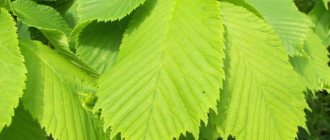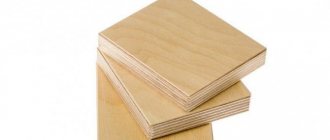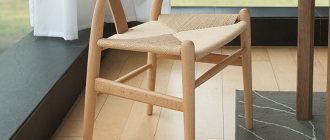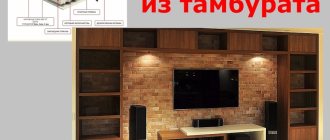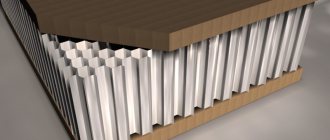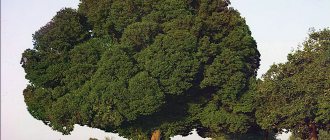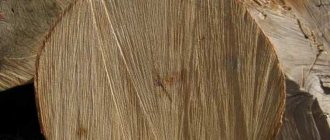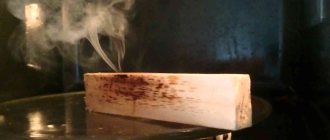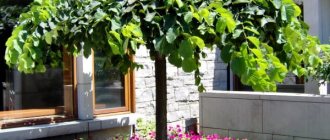Tall and squat, powerful and refined, with a spreading, luxurious crown and beautiful leaves - these regal trees serve as a worthy decoration of the streets of many cities. Elms are constantly planted in parks, alleys, squares and in the courtyards of residential buildings. In the modern world, their noble genus includes more than 20 species. The elm tree appeared about 40 million years ago; it is believed that it was then that it became an independent family. He was revered for his unusual qualities by the ancient Greeks and Romans. It is known that in ancient times elm grew on a large part of the Apennine Peninsula. And according to the Old Slavic legend, Svarog himself, the revered god of the Eastern Slavs, walked near the trunk of this wonderful tree, together with the goddess of love Lada.
Elm, which literally means “flexible twig,” belongs to the genus of very ancient elm trees. In Europe they are called elms (from the Celtic word elm), and among the Turkic peoples elms are better known as elms.
Description of the elm tree
Mature trees of most types of elm look like powerful giants, sometimes reaching a height of up to 40 meters, and a trunk diameter of up to 2 meters. Their crowns are dense and cylindrical in shape. The bark on the trunks has a rich dark brown color, and the tree remains smooth for a long time.
Elms bloom in April-May from several days to a week: small greenish-yellow flowers are collected in spherical bunches. At the flowering site, flattened fruits-nuts, bordered by wings, sprout. They ripen with the onset of warmth, and are carried by the wind throughout the area. Branched elm is densely covered with foliage with characteristic jagged edges. A slight slope can be observed at the base of the oval leaves.
When describing the elm tree, it is worth mentioning its root system, which can successfully compete with oak. This is a highly developed network with individual roots going both to the surface and to the depth. In podzolic soils they are widely separated from each other. Sometimes, especially in large trees, disc-shaped roots may form at the foot of the trunk, serving as their support.
Collection and preparation of elm
Traditional healers and healers use elm bark, seeds, flowers and foliage for medicinal purposes. Flowers are collected in early spring (at other times the tree does not bloom) and, like foliage, dried in the shade, in a draft, under canopies.
Bark for harvesting is taken only from young trees in the spring, when it is easily separated from the trunk. The collected bark must be crushed and slightly dried, then dried to completion in a dryer or oven at a temperature of about 60-70 degrees. For storage, it is better to use linen “breathable” bags, and if there are few raw materials, then paper bags will do just fine.
Features of elms
A remarkable feature of elm trees is that some of their species can grow on quite difficult soils. They tolerate drought, wind, severe frosts well, and are able to grow on saline lands. That is why these trees have become indispensable in steppe forest plantations, shelterbelts and water protection zones. But elms grow more happily where the soils are rich and loose. Thus, their life expectancy will entirely depend on the conditions of their growing environment, and usually on average it is 200-400 years.
Planted elms with their powerful, beautiful crown look decorative and provide diffused shade, which is why they are often used for urban landscaping. They look great in both single and group plantings. The foliage is brightly colored and, depending on the type of tree and time of year, is replete with burgundy, yellow-orange, green, and brown flowers. Elm foliage tolerates exhaust gases well, purifies the air, and traps dust.
Elm forests
In nature, pure elm forests are extremely rare. Their massive plantings are observed in coniferous-deciduous and broad-leaved forests in Asia, Europe, Scandinavia, North America, and the Balkans. And if in Europe the smooth, rough, elliptical, leaf elm is more common, then in Asia it is the squat, valley, lobed elm, and in America it is the American elm.
In Russia, deciduous elm trees grow in the Far East, the Southern Urals, the southeastern part of the Russian Plain and the Central region. The most common forests contain the following types of elms: leaf, lobed, small-leaved, smooth, cork, mountain (rough), large-fruited and Japanese. Preferring fertile soils, they grow mainly along the shores of lakes and in floodplains. The total area of such plantings occupies 500 thousand hectares.
Smooth elm
Smooth elm (or common elm) can be found mainly in deciduous forests in central Russia, Siberia, and also in Kazakhstan. The elm tree easily tolerates shade and harsh winters, but prefers moist and fertile soils. Its height is on average 25 meters, and its wide crown is shaped like a ball. Elms of this species live up to 300 years, and their intensive growth is observed immediately after planting.
The peculiarity of the smooth elm is its thin hanging branches with a smooth and shiny bark. In older trees, this bark cracks and forms peeling plates over time. The elliptical leaves have a smooth surface on one side and are covered with hairs on the other side. With the onset of autumn they take on a rich purple color.
Garden varieties and types of elm with photos
Mountain elm or rough elm variety "Camperdownie" (Ulmus glabra Camperdownii). It is a picturesque low tree with a characteristic weeping crown in the form of an umbrella of hard shoots.
The height of "Camperdownii" is usually 2 - 2.5 m. After a few years, the width of the crown can reach 6 - 18 m. The leaves are large, hard, and numerous. In autumn they acquire a golden yellow color.
Weeping elm "Pendula" with a compact crown. Another low-growing variety of mountain elm with shoots that form a green tent. Trees prefer sunny places and fertile soils.
The same type of variety from the Dutch (formerly "Monstros"). A rare dwarf elm, one of its smallest forms. Grows as a compact, round bush. At maturity, its size is only 40 cm in height and 40 cm in width.
The leaves are large, about 4 cm, which is special for this small plant. The unique appearance and shape of the variety fits perfectly into compositions of low-growing shrubs, coniferous crops and cereals.
Cork elm or elm (U. Minor). Synonyms: small, field or hornbeam elm. In nature, it is a powerful, long-lived tree that grows throughout Europe. Three varieties have become widespread in horticulture.
"Argenteovariegata". The decorative nature of elm lies in its variegated foliage with white and cream spots. It grows slowly. The height of an adult tree reaches 10 meters, and the width of the crown is 5 meters.
Typical requirements for this species are fertile, moderately moist soil, a sunny location, which enhances the brightness of the foliage color.
In the garden, “Argenteovariegata harmonizes well with other variegated plants, although such original varieties are usually planted separately to create a strong accent in the garden design.
"Webbiana" is an ornamental elm with a unique type of foliage. Throughout the season, the leaves of this tree are slightly curled. It seems that the tree is drying out or sick.
Meanwhile, this is a feature of the varietal form. Produces a wide crown of several large, strong branches. The maximum height is about 4-5 meters. It grows well in moist and fertile soil, but due to the structure of the foliage, which reduces water evaporation, the variety is resistant to prolonged drought. The most popular and incredibly beautiful variety of this species is “Jacqueline Hiller”. Compact, low and slow growing tree. Its decoration is small, densely spaced, slightly curled, dark green leaves about 2-3 cm long.
Young leaves are pink. The varietal form is grown both on a standard and in the form of a bush. Can grow in any light. The variety is resistant to diseases and low temperatures, and can grow in fertile and poor soils. After 10 years, its height reaches 1.8 m.
White or American elm (Ulmus americana). This tree is incredibly hardy; unlike many ornamental varieties and hybrids, it can withstand temperatures down to minus 42 °C! Unfortunately, this species is susceptible to Dutch disease.
Variety "Beebes-Weeping"
The tree has a high, slightly lacy crown. An interesting fact is that the American elm is not sensitive to photoperiod length - it will continue to grow throughout the fall, despite the shortening days, until its growth is stopped by frost.
Squat elm (U. pumila) or small-leaved elm (Ulmus parvifolia) is native to East Asia. A small evergreen shrub or tree that is ideal for creating a bonsai style. The leaves are small, some varieties have small, shiny leaves.
Highly decorative variety "Geisha". In spring the leaves are white-green and white-cream, but after a short time they turn dark green with cream-colored teeth along the edges. A tree with a picturesque crown, some of the branches grow vertically, and some hang slightly to the ground, often sold as a trunk.
The variety is completely frost-resistant, although it is not recommended to plant it in places exposed to strong winds. Requires fertile, moist soils and plenty of sun, which affects the bright color of the foliage. The maximum height is about 3 meters. Looks great as a tapeworm around the house or on the lawn.
"Hokkaido" is a dwarf Japanese variety. In eastern countries it has gained great popularity as an excellent material for forming elm bonsai. It grows in the form of a bush with a dense, branched, oval crown. Height is about 50-70 cm.
The shoots are thin, intricately curved, densely leafy. Thanks to the form of shoot growth, this tree is decorative not only during the season, but also in winter! It has very high tolerance to different types of soil, although it grows best in fertile and moderately moist soils in full sun.
The variety is completely frost-resistant, but it is better to grow it in places protected from the cold winter wind. In the garden it looks great in rock gardens, on alpine slides, along paths. This planting allows you to appreciate all the advantages of the varietal form.
A very famous hybrid in horticulture is the Dutch elm (Ulmus x hollandica) of the “Wredei” variety. A low tree with a narrow conical or cylindrical crown.
The shoots are densely leafy. The leaves are wide, tightly adjacent to the shoot. In spring they are light yellow and in summer they turn golden green. The leaf shape is slightly curled. The tree grows slowly and after 10 years reaches 4 m in height.
The plant has low soil requirements and is frost-resistant. The recommended variety is excellent for color compositions; it looks especially beautiful next to varieties of trees and bushes with green and purple foliage (barberry, elderberry, scarlet).
The variety can grow in sun and partial shade, is drought-resistant, but when planted in the sun it requires regular watering.
Large-fruited elm
Large-fruited elm is widespread in China, Korea, Mongolia and the Russian Far East. The species got its name from its large edible fruits. Elm looks like a shrub or small tree 6-8 meters high. Its dark brown or gray bark can crack deeply. The leaves have a pointed apex and an unequal wedge-shaped base, and the edges are edged with short serrated teeth. Being one of the most unpretentious and drought-resistant plants, elm grows in open places: along rocky crevices, ravines, on rocky slopes, at the foot of hills and on scree along rivers.
The spreading impressive crown, shiny leaves and large fruits make this type of elm decorative, as a result of which it is successfully used in landscape design and urban landscaping.
small-leaved elm
Small-leaved (or squat) elm is widely distributed in natural conditions on the islands of Japan, northern Mongolia, eastern Kazakhstan, the Far East and Transbaikalia of Russia. It is also successfully cultivated in North America and Southern Europe. Mature trees of this species are of insignificant height and barely reach 15 meters, and their trunk diameter is no more than a meter. Elms have a dense tent-shaped crown, sometimes growing as a bush. Thin yellowish-green branches are strewn with small, simple, elliptical or broadly lanceolate leaves ranging from 2 to 7 cm in length. In autumn they acquire an olive-yellow color.
Small-leaved elm is very light-loving and unpretentious to the soil; it also tolerates frost and drought well. Thanks to these biological features, it is successfully used in forest shelterbelts and for forest restoration.
Elm veneer
Elm, which grows in the vast expanses of the Eurasian continent, is called white elm. It is not suitable for veneering, as it is susceptible to disease. Due to the disease of the species, there is a risk of partial or complete destruction of the wood structure. But there is an alternative option for producing elm veneer. The so-called American elm or red elm is excellent for veneer production. At the same time, it has a reddish-brown texture, which makes it more exotic. This elm grows in both Americas and Canada. The use of solid wood is not economically feasible in our region. But it is beneficial to use veneer. It will not only create a beautiful visual effect, but will also perfectly protect cheaper types of wood from mechanical damage.
Elm lobed
The lobed (or split) elm is biologically close to the rough elm, common in Europe. Under natural conditions, it is found in the Far East, Sakhalin, Japan, Korea and China. It grows mainly in mixed forests of foothills and on mountain slopes, reaching a height of up to 700 meters above sea level. The species owes its name to the original shape of large leaf blades resembling blades. Its trees with a dense cylindrical crown reach an average height of 25 meters.
The lobed elm grows very slowly, by the age of 30 its height is only 8 meters. It is more demanding on soils, compared to its other relatives, and is not resistant to salts. At the same time, it is shade-tolerant, wind-resistant and tolerant of frost, although young elm trees often freeze slightly in winter.
Description of elm. Kinds
Stately elms decorate the streets of many communities.
The elm family is a genus of impressive trees and shrubs, most of which shed their leaves in the winter. Elm got its name because of the distinctive features of the tree species. In the old days, sleds and rims were knitted from bast wood. Bast was extracted from the subcortical bast shell. The Latin name of the tree is Ulmus. According to one version, it comes from the ancient Celtic word elm. Cork growths have every chance of forming on the shoots of the majority of southern trees. The root system is quite powerful. Single roots go so deep that they often reach the level of groundwater flow, while many occur close to the surface. Elm leaves have a pointed shape with an abundant number of teeth and flying stipules. The flowers are rather unsightly. Smooth elm (ordinary) is a deciduous tree, on which dense clusters of small greenish inflorescences awaken with the advent of warmth. Flower buds are larger in size than leaf buds; they are grayish-brown shoots, wrapped in a thin shiny film, which in the future becomes covered with a network of cracks. In a significant number of cases, the elm does not exceed 35 m in height and 1 m in diameter. The crown of the tree is dense, extensive, cylindrical. The dark emerald color of the leaves disappears with the onset of frost, they become yellow-brown. While the tree is in a period of intensive growth, its bark is quite smooth and thin, but as the tree gets older, the bark becomes much rougher. As soon as the elm gets stronger, the rich grayish-brown tone is shrouded in abundant deep cracks. There are approximately 10 species of elm growing in the Russian Federation. Almost all are long-livers - they can reach an age of about 250-300 years.
Ordinary. Depending on soil fertility, the trunks rise to a height of up to 25 m, the diameter is up to 1.5 m in mature individuals. The bark is black-brown, convex, rough. Leaves are up to 15 cm long, 10 cm wide, elongated. Flowers bloom in April, after 7-12 days small fruits with membranous lionfish are formed. The common elm grows rapidly, withstands pruning excellently, and forms dense shade. It is used for landscaping parks, adjacent areas, alleys.
Squat. Compared to related giants, its maximum height is 15 m. The size of the leaves is no more than 4-7 cm. In spring, the foliage of the squat elm is velvety emerald, leathery, and darkens in summer. The inflorescences are small, yellowish-brown in color. It is undemanding to soil composition and withstands drought well.
Lobed . One of the most popular Far Eastern varieties, due to the unusual appearance of impressive leaves resembling pointed blades, is often called split. It grows mostly in high mountain areas. The trunks reach up to 25 m in height, the crown is cylindrical in shape, very dense.
Rough. This species loves fertile lands and does not tolerate extremely salty ones. The trees are straight-trunked, with smooth dark brown bark. The leaves are quite large - within 17-20 cm, oval, pale green, rough at the top, with a hard fleecy surface on the back. Life expectancy is up to 400 years.
Androsov's elm. An artificially produced cross between the squat and bushy elms. A mature tree can reach 20 meters in height. It has a dense spherical crown. Covered with ash-colored bark. The leaves have a pointed shape. It often grows in moist soils, but can easily tolerate drought. The crown lends itself well to shaping, which is what allowed the elm to be one of the most popular garden trees.
David's Elm . Distributed mainly in the Far East, China, Korea, Japan and Mongolia. It can grow as a bush or tree up to 15 m tall. It has moderately sized, oval-shaped leaves pointed at the ends. David's elm has a subspecies - Japanese, which at times stands out as a separate species. The oldest David's elm grows in Korea, its age is approximately 800 years.
American. Its homeland is North America. It was brought artificially to Europe in the 18th century, but did not gain due popularity. It often grows on the banks of lakes and rivers, but is also found in drier areas. It grows up to 30 m, occasionally reaching a height of 40 m. The crown has a cylindrical shape, the trunk is covered with pale gray scaly bark. The elongated leaves have a pointed shape and are medium in size. Resistant to frost.
Small. This species has a lot of different names - birch bark, elm, red, cork or field. Distributed in Western and Eastern Europe, in Asia Minor. Depending on conditions, it can grow from 10 to 30 m. The crown starts almost from the ground. The lifespan of such a tree can be 400 years. Elm loves well-lit places, tolerates drought excellently, but poorly adapts to low temperatures. A characteristic feature is an extensive network of roots protruding above the surface of the earth. This root network makes it possible to significantly reduce the impact of erosion. For this reason, the small elm is often used to form a protective forest belt.
Large-fruited . This species grows in the Far East, as well as in China, Mongolia and Korea. Grows on high slopes and river banks. It has the form of a shrub or tree up to 11 m high, with a developed spreading crown. Old branches and trunk are covered with pale brown, in rare cases yellowish, bark. The foliage is large, glossy, rough on top and smooth below. The species got its name because of its large fruits, compared to other varieties of elms. Trees of this species are heat-loving and can withstand frost. But, unlike others, they have the highest drought resistance. Large-fruited elm is actively used to strengthen the walls of embankments, quarries, and cliffs.
Geography of growth.
Depending on the species, elms can grow in Western Siberia, in the Caucasus Mountains, in Transbaikalia, in the Far East, in countries such as Korea, China, Mongolia, Japan, in the countries of Asia Minor, Central and Central Asia, in the countries of both Americas, almost everywhere in Eastern, Southern and Western Europe and even the countries of North Africa, in deciduous and coniferous-deciduous forests. Along the river banks in the north, the growing areas wedge into the European dark coniferous taiga, and in the south - into the steppes and forest-steppes. Typical in ravine forests and small forests of steppe shrubs. Southern varieties of elms are small trees of open spaces, pioneers in secondary plant formations. The northern varieties are trees of the first or second size, growing in admixture with the main species, and in coastal forests from time to time they dominate the forest stands.
Properties of elm wood.
Elm trees are core ring-vascular species. Annual circles are clearly visible in absolutely all sections. In their early location, a ring of large vessels is recognizable. On a cross section in late woody species, light wavy solid lines are noticeable, which are directed along the boundary of the annual layer or at a certain angle to it.
Unlike oaks and chestnuts, which have a circular arrangement of vessels, in elms they are located tangentially. Vessels occupy from 25 to 49% of the total volume of the tree species (for oaks 26%, for ash trees 11.5 - 20.5%). The heart-shaped rays are visible only in a circular section in the form of small lines. They do not stand out in color from the wood around them and are identified only by their characteristic shine. In mountain elm, in a circular section, much darker lines with an inherent radiance stand out, giving the wood a special pockmarked appearance.
Elm wood has a texture with large anatomical micro-irregularities (more than 200 microns), which is identical to the texture of oak. Elm growths have a particularly luxurious texture and are highly valued. The moisture content of wood in a freshly cut state is 78%.
Wood is difficult to process with cutting devices, especially when planing, but it polishes and glues perfectly. When grinding, it requires preparatory filling of pores and application of primers.
During drying in chambers, it does not warp or crack; the drying time from natural to 8-10% moisture is the same as for oak. Dried wood is not resistant to rotting in atmospheric conditions. But in land and water it shows itself literally in the same way as larch. For this reason, it is used for the lower rims of well log houses and for piles of hydraulic structures and bridges.
In terms of wear resistance, elm wood is practically not inferior to trees such as beech and ash. A characteristic feature of the tree species is its extraordinary susceptibility to bending.
Use of elm wood.
Elm wood was highly valued back in the period of Ancient Rome. At that time, elm, together with oak and chestnut, made up an impressive part of the entire forest abundance of the Apennine Peninsula, playing an important role in the economy of the Roman people. Porcius Cato in the 1st century BC wrote about elm as an excellent building material, and Pliny the Elder also mentioned the presence of elm nurseries - Ulmari.
Elm wood has always been important in Russian folk crafts. The arcs, shafts, and runners made from it were of the highest quality. Another important feature: elm wood is not afraid of water, being used in mines, in the construction of dams, canals, and sluices. In shipbuilding, it is used not only for the decoration of salons and premises, but also for the manufacture of ship hull components.
Some buildings in Venice stand perfectly on stilts made of elm. Elms are widely used in landscaping due to the fact that almost all varieties have a dense, shady crown. Their foliage creates such a barrier to dust that elm is recognized as one of the best air purifiers. Small-leaved elm leaves accumulate 7 times more soot than poplar foliage. Elm elm with its small, tightly packed leaves also serves as an excellent vacuum cleaner.
Elm, elm, and birch bark wood are approximately similar in properties and are used in the same areas: for the manufacture of furniture, sliced veneer, in wagon production, and in mechanical engineering. Elm and birch bark wood, which has an elegant texture, is used mainly as a finishing material, as well as for artistic works.
Peculiarities of processing elm wood.
When processing elm wood, conventional carpentry equipment is used. Due to its properties of strength and hardness, elm is occasionally cut to give rounded shapes. There is a technology for bending elm, in which it is treated with steam. With further drying, it is restored to its original strength and holds its shape perfectly. Difficulties also arise when polishing elm. Therefore, it is often varnished or covered with decorative compounds.
Elm tolerates chemical attack remarkably well. The wood material adheres well and is friendly with metal parts. Due to its prevalence and unpretentiousness, elm is excellent for novice carpenters and furniture makers.
The range of uses of elm lumber is varied. You can make stools and more complex furniture using turning and carving. Elm sapwood has a pale yellow, uniform texture, thanks to which the product can be coated with various stains and varnishes. In a similar way, you can achieve the effect of a much more expensive type of wood, and in terms of strength, elm is definitely not inferior to it.
Elm is not suitable for veneering, as it is susceptible to disease. Due to the disease of the breed, there is a risk of selective or complete destruction of the wood structure. But there is also an alternative option for making elm veneer. The so-called North American elm or red elm is excellent for veneer production. At the same time, it has a reddish-brown texture, which makes it more exotic. A similar elm grows in both Americas and Canada. The use of solid wood is not economically feasible in our region. And it is beneficial to use veneer, because it will create a beautiful visual effect, but will also perfectly protect cheaper types of wood from mechanical damage.
rough elm
Rough elm (or mountain elm) grows in Eastern and Western Europe, and is found in deciduous forests in the European part of Russia. Straight-trunked trees have smooth dark bark with brown branches and a rounded, lush crown. Large dark green leaves on very short petioles grow in strict order, so the foliage almost does not allow light to pass through. It has a rough surface on top and hairy underneath, externally presenting certain patterns. When autumn arrives, the leaves turn a rich yellow color.
The rough elm is picky about soil and moisture, but gets along well in urban conditions - it is gas-resistant. Under favorable environmental conditions, the elm tree reaches a height of up to 35 meters and lives up to 400 years.
Elm meaning and uses
It is difficult to overestimate the importance of elm. Its bark, fruits and leaves are successfully used in folk medicinal recipes. It is important to talk to your healthcare professional before using elm in the treatment of various diseases. Therapy has side effects and contraindications.
Decoctions based on bark and leaves help reduce inflammation, have antibacterial properties, and help heal damage. The extract is used for the treatment of kidney, heart, blood vessels, thyroid gland, etc.
A decoction is useful for throat diseases. So, if you have a sore throat, it is recommended to gargle with it. Tea from the leaves is used for constipation. In case of hemorrhoids and kidney diseases, baths with elm bark are recommended. The tincture is used to get rid of skin rashes.
Elm wood is often used in industrial production due to its excellent properties. Elm wood is often used as an alternative to expensive wood species. Its texture allows you to imitate valuable varieties, with a fairly light color. Mahogany connoisseurs love elm. Elm is used to make furniture for the home and is also used to make paintings.
The density of elm wood is very high, approximately 600 kg/m3. The cut of wood has a beautiful texture, which makes it suitable for use in carpentry. It is resistant to rotting processes and is difficult to split and saw. However, it behaves very well when polished.
In the old days, elm was also used in carpentry workshops, and paint was made from its bark. Without taking into account the pests that attack the tree, it is often planted in parks, around the city, and in social institutions.
Use of elm in economic activities
The average lifespan of elm is 80-120 years. 400-year-old specimens are known.
Elm wood is hard, strong, viscous, elastic, easy to process, but difficult to split. Its heartwood is dark brown, the sapwood is lighter with a characteristic pattern of broken or parallel stripes, with narrow core rays.
In water it resists rotting well, but this ability is lost upon contact with soil. A growing tree is often attacked by insect pests and parasitic fungi.
The first written mentions of elm date back to the Mycenaean period. The chariots used in the Battle of Knossos had wheels made of elm wood. In Ancient Greece, plows were often made from it. And elm burns excellently; its wood tends to ignite even when wet. Any fire can be easily lit from the logs of this tree. Yes, you can light a fire from logs, but cooking these logs is not so easy. However, we conducted an experiment: although elm does not famously scatter into logs, it is still not difficult to chop firewood from it if you get a good tool.
The Russian name of the tree speaks for itself - elm - from “knit” or “knit”. In the old days, sleighs, rims and other products were knitted from its bast. And for those who have chopped elms for firewood, the second meaning of this name is clear - if you drive an ax into a log with all your might, but it’s still intact, and you can’t even pull the ax out - it gets stuck. It is difficult to split an elm block because the layers of the tree's wood are uneven and difficult to separate from each other.
People use elm very widely:
- fruits - as a highly nutritious feed for pigs and other domestic animals. Young branches and bark are also used to feed livestock;
- for landscaping cities, since many of them are undemanding to living conditions. But in the steppes they suffer greatly from pests. In Europe and North America, the era of elm landscaping ended between World Wars I and II, when the trees were damaged by war and an outbreak of Dutch elm disease. The revival of plantings began in the 1990s. Then new, more resistant varieties of elm were developed. In total there are about 300 new varieties of wood. And the old pre-war varieties were lost;
- as an early honey plant;
- Due to its high density, elm is difficult to cut and split, but bends quite well. The smooth surface of the material tolerates polishing well. Fresh timber practically does not crack or warp when dried. A variety of bent products are made from it, for example, arches, rims, ship keels, etc., as well as small carpentry crafts. In ancient times and the Middle Ages, bows were made from elm when yew was unavailable;
- the bark is used for tanning leather products;
- Ropes and mats are woven from bast. They turn out to be very durable;
- water pipes were made from elm trunks, and the supports of the first London Bridge were made from them;
- wood is widely used in carpentry, furniture industry and mechanical engineering. Because of its density and viscosity, it was used to make wagon wheel hubs, baseball bats, gun butts, chair seats, wooden frames, parquet floors, door handles, etc. Now elm is mostly used in the form of veneer for refining lower-quality tree species or combined with other materials when finishing premises;
- Elm is edible! Its bark, cut into strips and boiled, sustained much of Norway's rural population during the Great Famine of 1812. Elm seeds are especially nutritious; they contain 45% crude protein and at least 7% fiber in dry weight;
- Chinese elm is popular for bonsai because it is tolerant of pruning.
In Russia, 10 species of the genus grow under natural conditions. The most common of them is the common or smooth elm (Ulmus laevis).
Greening the city
When carrying out landscaping in cities, elms are planted as single trees (tapeworms) or in groups of 5-10 trees. In urban conditions, it develops a powerful spreading crown, which visually enlarges an already rather large tree.
In the spring (April - May), the tree attracts attention with its many flowers, the color of which is dominated by brown shades. In summer, elm boasts dark green leaves that effectively set off the light skins of the fruit, and in autumn it has a golden-yellow crown.
Elm is a tree that easily tolerates pruning and can be used as a hedge. Since about 12 species of elms grow in the territories of the post-Soviet space, within one city you can find several different forms of it, differing from each other not only in color, but also in the shape of the leaves.
Application in landscape design
The mighty elm has a lush, dome-shaped crown. Due to the fact that the foliage is very dense, it is able to protect residential areas from gas, dust and dirty air, trapping them. In addition, the elm looks very impressive and provides a thick shadow.
Landscape designers often create various shapes from the crown of elm due to the fact that the plant has dense branches. A well-developed strong root system helps strengthen the slopes of ravines, river banks and lakes.
Such a tree is often planted in the local area. It is used not only for decoration, but also to strengthen the soil. This allows you to protect the nutrient soil from sliding, erosion and weathering.
When choosing the type of elm and where to plant it, it is important to consider the size of the mature tree. Today, there are both very large varieties of elm and miniature ones. For example, in a vast area there will be few short elms, and large tall trees are not suitable for the local area.
Hornbeam elm
Hornbeam elm is a luxurious deciduous tree with a spreading crown, reaching a height of up to 35 meters and a trunk diameter of more than 150 cm. It is distributed in the Caucasus, Central Asia, North Africa and the European part of Russia. The wide trunk of the tree is covered with smooth bark from below, and in the area where branches appear it becomes rough. Its long branches are spread out like a fan and covered with serrated unequal leaves, very varied in size. The elm tree blooms generously in the spring with small flowers, and towards autumn bears fruit with white nuts.
This type of elm is popularly known as elm. It is characterized by strong salt tolerance and drought resistance, therefore it is widely used in steppe breeding, arid areas, and in shelterbelts.
Healing recipes based on elm
Recipes from elm leaves:
- Infusion for external use for skin diseases and internally as a laxative: Grind a tablespoon of elm leaves and pour a glass of boiling water, boil over low heat for a couple of minutes and leave to infuse for an hour, strain before use.
- A decoction used for cancer: For 400 milliliters of water, take 3 tablespoons (tablespoons) of dry crushed raw materials. Boil for 5 minutes, strain. Half a glass of decoction is taken per appointment, consume up to 4 times a day.
- Infusion for cystitis, and for compresses for dermatitis: Take a glass of boiling water for a tablespoon of dry leaves (carefully crushed). The leaves are boiled for three minutes and infused for an hour. The infusion is filtered before use. Take a third of a glass three times a day.
Elm bark recipes:
- Tea for rinsing for inflammation of the mouth: 3 level tablespoons of bark and 250 ml of water, bring to a boil and strain. Use undiluted.
- Infusion for the treatment of psoriasis: A tablespoon of bark is poured into 1.5 cups of water and boiled for about 6 minutes, then infused for an hour, filtered and taken in 40g doses. (not a full stack) three times a day.
- Infusion for cancer: Pour a tablespoon of elm root bark with a glass of boiling water and simmer for 10 minutes over low heat, close the container in which the bark was boiled with a lid, wrap and leave for a couple of hours. Take one shot glass (approximately 50 grams) twice a day.
- Water suspension for diarrhea: Elm bark, crushed into powder, is mixed with water to the consistency of a suspension. Use half a teaspoon twice a day.
Breeding
Elms reproduce by self-seeding. Their seeds ripen in May-June and lose their viability in a short time. Therefore, only freshly collected material will be suitable for planting. In nature, they can also reproduce by shoots and root suckers, but for amateur nurseries such methods are ineffective when breeding trees.
It is recommended to store elm seeds in conditions of good ventilation for no more than one week until sowing. A couple of days before planting, they are moistened and treated with a fungicide. Planting sites do not require preliminary preparation, but you can add a little mineral fertilizer to the soil. The seeds are sown in rows at a distance of 20-30 cm between the holes at a shallow depth - only 1 cm. They are covered on top with hay, moss or a thin layer of soil and watered well. Shoots appear within a week. In the first year of life, elms grow up to 15 cm, in subsequent years they add up to 40 cm.
Planting and caring for elm
Growing an elm tree in your yard is not particularly difficult.
You can plant it with seeds, they sprout quickly.
- They are collected when the tree has flowered and placed on damp cotton wool; the seed is immediately treated with a fungicide.
- This treatment will protect the future plant from the fungus, which will be difficult to remove once it appears.
- After a couple of days, the sprouted seed is transplanted into a container with soil; black soil is best; the plant will germinate more safely in it.
- If there is no black soil, you can use humus with soil; the soil should be moistened and loosened.
- The seeds are planted to a depth of about two centimeters.
- There should be a distance of twenty-five centimeters between planted seeds.
- The top soil is covered with moss or hay, you can again use cotton wool.
- The soil needs to be watered every day, and after ten days shoots will appear and it will be possible to remove the material that covered the soil.
It is recommended to expose young shoots to sunlight.
Seeds are germinated at the end of spring, which is the most active growth of all plants.
In good weather, with little wind, the shoots are left on the balcony or in the garden.
For your information. In the first year of life, seedlings grow twenty centimeters, and the next year they can be planted in open soil.
Root system
The elm root system is so powerful that it can successfully compete even with oak roots. Not only the main taproot, through which the tree receives its main supply of nutrients, penetrates into the soil to a sufficiently great depth, but also the lateral ones. It is this property that makes it possible to ensure significant stability of the tree even in strong winds.
For example, when planting on shelterbelts, they restrain the main gusts of wind, allowing you to obtain full-fledged crop yields, the ripened seeds of which practically do not fall to the ground.
Care and breeding
Reproduction of elms occurs mainly by seeds. The tree can also be propagated by shoots. If the seeds are placed in an airtight container, they will be able to retain their germination properties for 2 years. After the seeds ripen, they are planted after two weeks.
The plant does not require preliminary soil preparation. They must be laid out in the soil at a distance of 20-30 cm from each other, covered with a layer of soil and watered abundantly. During the first month, the seeds are watered regularly and abundantly. In very hot weather, it is advisable to cover the seeds with film until the first shoots appear. As the young tree grows, it will be easy to tolerate excess moisture or drought. Young shoots grow well even in the shade.
Before planting seeds or seedlings, you should consider the growth rate of the plant. After 2-3 years, the tree can shade other plantings. It is known that elms have a negative effect on grapes, so they should not be planted nearby.
Reproduction
Elm propagates primarily by seeds, but cuttings can also be rooted. To do this, cut the cuttings in late autumn and treat them with special means to stimulate root formation. After this, it should be placed in water and wait for roots to appear. You can plant the cuttings after the first roots appear. For planting, special loose and nutritious soil is required.
Diseases and pests
Typically, elm is affected by elm springtail, scale insects, and leaf beetles. It is easy to identify a disease in a tree; its crown dries out and growths appear on the bark. To combat parasites, treatment with liquid copper sulfate, insecticides and fungicides is used.
Young trees are easier to get rid of diseases. Old elms are difficult to get rid of parasites, especially fungi. That is why the use of antifungal agents is recommended at the planting stage.
Interesting Facts
- The famous London Bridge owes its stability to the elm wood that was used in its construction.
- In Korea, there is an elm tree whose age has exceeded 800 years. It is very small in height, only 7 meters, but in diameter it reaches almost 2 meters.
- In ancient times, the elm was used to support a vineyard, causing the Greeks to associate it with the god of wine, Dionysus.
- Elm fruits are widely used in Chinese cuisine and are a common ingredient in salads.
- The aroma of elm wood acts on humans as an antidepressant and gives a calming effect.
- Until recently, on Povarskaya Street in Moscow, a long-living elm, which witnessed the fires of 1812, was “whileing out” its old age. But the tree could not withstand the abnormal heat of 2010 and withered.
- Many buildings of the beautiful Venice, the famous city on the water, stand on stilts made of elm.
- The Slavic name for the elm tree comes from the verb “to knit,” since the tree’s twigs were successfully used in the process of knitting sleighs, baskets and other household utensils.
- In England, the elm and the vine symbolize faithful lovers.
Elm. Beneficial features
A decoction of elm bark is widely known and used in folk medicine, for diarrhea, to relieve the symptoms of gastritis, and helps in the treatment of ulcers.
Decoctions of elm leaves help against intestinal and kidney colic. Gruel from fresh elm leaves promotes wound healing. Compresses help with scabies and eczema.
Preparations based on elm leaves and bark have a beneficial effect on cardiovascular activity and normalize metabolic processes in the body.
Elm bark infusions are effective for cystitis.
The main effect of elm bark and leaves is anti-inflammatory.
Subscribe to our Yandex.Zen channel
